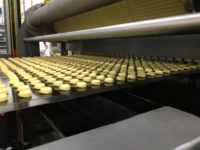Since the beginning of 2020, when the COVID-19 pandemic began its destructive spread across the earth, the baking industry has seen highs and lows unlike any other time in history. This unprecedented challenge has reshaped our world, and much of the industry is emerging stronger than ever.
“Resiliency, strength, and unity all describe the current state of the commercial baking industry,” says Robb MacKie, president and CEO, American Bakers Association (ABA), Washington, D.C. “The past year has been one of—if not the—most-challenging for our industry in modern history. Despite these challenges, a significant segment of the industry has flourished, while those that struggled have persevered.”
The industry is poised for a strong year of growth, even by those hardest hit by the pandemic, suggests MacKie. “In March, the ABA Virtual Convention pushed themes about going on offense and building on the momentum of the renewed connection with consumers around bakery products.”
Despite underlying optimism, however, significant storm clouds sit on the horizon that will require careful navigation, says MacKie. “The industry is facing unprecedented inflationary cost pressures across the board. Current and proposed policy initiatives exacerbate these cost pressures. Some of these initiatives are well-intended, while others are extremely misguided.”
An essential workforce
Leading these pressures is the increasingly desperate search for talented employees. “The industry has had a fundamental mission the past year: to feed the country and protect its essential workforce,” says MacKie. “Even those baking companies and suppliers that have struggled continue to support their local communities through feeding assistance programs and supporting their restaurants.”
Every year, regardless of external challenges and pressures, the industry must work to nourish the world—and that starts with every baking industry employee. “ABA has led the efforts to develop tools for the industry to retain, retrain, and recruit skilled employees,” says MacKie. “These initiatives were never truer than during the pandemic when needed health and safety precautions meant keeping employees away from facilities while maintaining operations. Bakers and suppliers worked hard to supplement their workforces by attracting new talent to a lifelong, fulfilling career.”
In some ways, the industry was slow to react to its workforce gap. “The industry has fallen upon its own sword in allowing the workforce experience to dilute in both experience and skillset,” says Ash Gurney, key account technical services manager, Dawn Food Products, Jackson, MI, and a member of the Board of Directors, American Society of Baking (ASB), Kansas City, MO. “The only practical opportunity to address this must be via by binding together for training, education, and industry-wide succession planning.”
The baking industry needs to position itself as a competitive opportunity. “We need to create an environment that competes with other professions that require similar skill and compensation levels,” says Scott G. Houtz, president, Air Management Technologies, Inc., Odessa, FL, and a member of the ASB Board of Directors. “It requires addressing cultural, environmental workplace exposure and creating a workplace life balance.”
A successful career path in industrial baking is one well known internally to the industry and one which has exploded in opportunity over the past decade, says Gurney. “What this has not addressed is attracting external newcomers to the industry—especially in light of an increasing talent and opportunity demand across most business sectors.” Where the baking industry has lost its way is highlighting and illustrating the career-based opportunities in baking, along with supporting industry-specific educational options, he says. “This becomes exponential when we add engineering and other supporting industry roles.”
We need a unified approach for the path forward—and it’s realistic that it will take a decade or more of sustained support and participation to build a critical mass of career-driven individuals at all levels, in all areas, says Gurney.
Many of the industry’s prevailing challenges predate the pandemic. “A limited labor pool has been an enormous challenge throughout the industry, and the issues have been exacerbated by COVID-19,” says Tony Graves, project manager, The Dennis Group, Springfield, MA, and chair, Bakery Council, Food Processing Suppliers Association (FPSA), McLean, VA. This has prompted more bakery companies to consider technological solutions. “An increasing number of producers are investigating or have made significant investments in automation,” he says.
“The movement from foodservice to retail and back to foodservice was dramatic,” says Graves. This includes dynamics related to carry-out. “An emphasis has been placed on designing flexibility into production and packaging lines to quickly make changes as needed to meet marketplace demand.” With increased flexibility, bakers can more-nimbly react to market fluctuations. “A combination of increased automation along with worker training and development programs will be important to maintaining consistent operations.”
The FPSA FIT Certification program was designed, in partnership with Lincoln Technical Institute, to develop a technical workforce for FPSA membership, notes Graves. FIT Certification was created to prepare future technicians for careers in processing, packaging, and equipment manufacturing, he says. “It’s also a way for current manufacturing workers to gain new skills and qualify for technician roles.”
In addition to the FIT program, FPSA offers its members access to the 180 Skills online training program. The program offers a variety of training modules, including: safety, communications, lean manufacturing, quality, Six Sigma, automation, electrical, hydraulics, pneumatics, robotics, welding, customer service, team building, time management, and conflict management, among many others, says Graves.
Fulfilling bakery workforce needs is essential as we continue to emerge from the effects of COVID-19, says Kerwin Brown, president and CEO, BEMA, Overland Park, KS. “Meeting the needs of the workforce is far more than a trend, it is an essential component of industry viability. People, the workforce, are the secret ingredient of the baking industry. Implementing solutions that make people feel safe at work, while also giving them the flexibility to work around the ever-changing needs of their family life, will be a prominent element of business planning going forward.”
A consolidated and collaborative approach will help the baking industry to address workforce development. “Identifying not only the training people desire, but the training they need to be effective and successful in their roles, will be beneficial to supplier and producer companies alike,” says Brown. “In regard to workforce development, the industry should not be competitive, but cooperative—working together to build the skill sets and talents within our industry provides unilateral benefits.”
Connecting and educating remain two of BEMA’s priority initiatives, says Brown. “In June, we will lead the industry in safely reconnecting during our in-person 2021 BEMA Convention being held on Marco Island. Reactions from both the supplier and producer registered attendees indicate a readiness from some in the industry to come back together for face-to-face conversations and connections.”
Regardless of an individual’s ability to travel to in-person events, education remains perennially top-of-mind. “We are addressing that with BEMA Convention 2021: Workforce Edition,” says Brown. “The Workforce Edition will provide targeted and engaging education to specific sectors of the workforce that are available to join most conveniently from the office. Creative new initiatives such as the Workforce Edition will help the industry by opening the doors of information sharing and networking to countless new audiences.”
At the outset of the pandemic, the federal government approved large, bipartisan relief packages designed to assist those who were struggling, says MacKie. “The short-term goals were very admirable—keep the economy and American families capitalized to allow for a more-robust economic recovery. As time went on, despite efforts by ABA and other manufacturing sectors, these efforts continued in one-size-fits-all manner. Bakers’ attempts to fill growing workforce gaps ran headlong into a potential pool of talent incentivized to stay out of the workforce. Frustratingly, federal leaders did not attempt to prioritize relief toward industries most in need.”
Emerging from the pandemic
Packaging will likely continue to factor into the post-pandemic world. “The most prominent change has been perceptions of food safety,” says Gurney. The COVID-19 pandemic has shifted customer expectations related to product safety. “This has catalyzed demand for individually wrapped products. The ability to deliver individually wrapped products has become a requirement—and this is here to stay,” he suggests.
“From a production perspective, innovations in packaging became wildly important during the pandemic, and I predict that consumer demand will continue to drive that trend throughout 2021,” says Brown.
Pricing issues are also top-of-mind for industry leadership. “Recent events have brought back the ghost of 2007–2008 and the worst commodity crisis in recent memory,” says MacKie. “If we recall, flour prices skyrocketed over 150 percent almost overnight. Other important commodities followed suit, many propelled by federal policies that exacerbated the problems instead. Today, we face a very similar situation with one key difference: The explosion in input commodity prices is not limited to grains. Shortages loom on steel and aluminum for equipment, films for packaging, oils, sweeteners and other important ingredients, and—most shocking—even gluten.”
Many of these challenges directly result from the global disruption of our highly connected global supply chain, says MacKie. “The massive disbursement of cargo ships and containers combined with severe struggles in operation of our ports have made it cost-productive to send ships back to their home ports empty (think industry tractor-trailers backhauling empty on steroids).”
As we emerge from the pandemic, these situations are highly concerning as they pertain to broader challenges to our country’s food security, notes MacKie. “They also are solvable or avoidable, but will take some time to unwind to stave-off more-serious food security issues. At best, this toxic mix of events will cause inflated food costs to consumers just as the economy begins recovering. At worst, this multifaceted chain of events will cause food shortages that could lead to the panic buying we experienced early in the pandemic. No one wants that scenario to play out.”
Protecting our food security is a top priority. The baking industry and other food sector partners must calmly and rationally explain the challenges and potential solutions, notes MacKie:
- We need to educate policymakers, customers, and our consumers on supply chain challenges and how they will be affected
- We need to demonstrate to lawmakers that their policy decisions have a significant impact on food security
- We need a more-targeted approach to our unemployment insurance and other assistance programs
- We need a short-term reprieve from the food vs. fuel pressures regarding federally backed clean fuel initiatives
- We need to fix our port access and our domestic supply chain infrastructure
- We need continued regulatory flexibility for new government mandates on labeling and enforcement discretion
“These are all heavy lifts, but we need to start the process,” says MacKie, noting ABA has initiated a supply-chain education and communications effort spanning the entire food industry. “We will also activate our Rise to Action grassroots action center and hold a virtual fly-in to educate policymakers. We are counting on our members to be the rational but loud voice of the industry to ensure our food security remains strong and vibrant. Together we can help solve these vexing challenges.”






